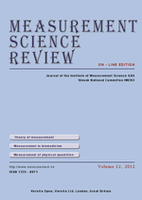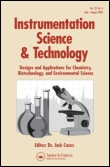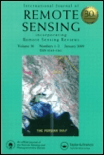
Geoscientific Instrumentation Methods and Data Systems
Scope & Guideline
Transforming Data into Insights for a Sustainable Planet
Introduction
Aims and Scopes
- Development of Geoscientific Instruments:
The journal publishes research on the design, calibration, and performance evaluation of various geoscientific instruments, including magnetometers, sensors for soil moisture, and remote sensing technologies. - Data Acquisition and Processing Techniques:
There is a strong emphasis on methodologies for acquiring, processing, and analyzing geoscientific data, including methods for improving data quality and accuracy in diverse environmental conditions. - Interdisciplinary Applications:
Research often explores interdisciplinary applications of geoscientific instrumentation, integrating fields such as meteorology, hydrology, and geology to address complex environmental challenges. - Real-time Monitoring and IoT Integration:
The journal highlights the integration of geoscientific instruments with Internet of Things (IoT) technologies for real-time monitoring and data transmission, enhancing the capabilities of environmental monitoring networks. - Methodological Innovations:
Innovative methodologies for data collection, such as automated systems, low-cost instruments, and novel calibration techniques, are a consistent focus, aiming to improve accessibility and efficiency in geoscience.
Trending and Emerging
- Enhanced Remote Sensing Techniques:
There is a growing emphasis on the development and application of advanced remote sensing methods, such as Lidar and satellite-based systems, which allow for comprehensive environmental monitoring and data collection. - Integration of AI and Machine Learning:
Recent publications highlight the application of artificial intelligence and machine learning techniques for data analysis and interpretation, showcasing a trend towards automated data processing and enhanced predictive capabilities. - Miniaturization and Cost Reduction of Instruments:
The journal reflects a trend towards developing low-cost, miniaturized instruments that maintain high accuracy, making geoscientific research more accessible and widespread. - Real-time Environmental Monitoring:
An increasing number of studies are focused on real-time monitoring solutions, leveraging IoT technologies to enhance data acquisition systems and improve response times to environmental changes. - Interdisciplinary Collaboration:
There is a notable trend toward interdisciplinary research, where geoscientific instrumentation is applied across various fields, including climate science, ecology, and urban studies, promoting comprehensive approaches to environmental challenges.
Declining or Waning
- Traditional Surveying Techniques:
There appears to be a decrease in publications focusing on conventional surveying methods, as newer technologies such as drone-based surveys and remote sensing are gaining prominence. - Static Instrumentation Studies:
Research centered on static or non-automated instrumentation is becoming less frequent, possibly due to the shift towards more dynamic and automated systems that offer real-time data collection. - Historical Data Reconstruction:
While still important, studies dedicated to reconstructing historical datasets or methodologies for data gap-filling have seen a reduction, as the focus shifts towards developing real-time and predictive analytics. - General Environmental Impact Studies:
Research that does not leverage advanced instrumentation or data systems is declining, indicating a trend toward more specialized studies that utilize cutting-edge technology for precise measurements.
Similar Journals

Measurement Science Review
Connecting Ideas in Biomedical and Engineering MeasurementsMeasurement Science Review is a distinguished open-access journal published by SCIENDO, dedicated to advancing the field of measurement science across various disciplines, including Biomedical Engineering, Control and Systems Engineering, and Instrumentation. Since its inception in 2008, it has actively contributed to the dissemination of innovative research and practices relevant to these fields, currently holding a notable Q3 ranking in its category as per the 2023 metrics. With an emphasis on robust scientific inquiry and practical applications, Measurement Science Review is positioned as an essential resource for researchers, professionals, and students seeking to enhance their understanding and expertise in measurement technologies. The journal provides an accessible platform for interdisciplinary dialogue and collaboration, making it a vital component of the academic landscape in Slovakia and beyond. Its publication track extends to 2024, ensuring timely access to cutting-edge research findings for a global audience.

INSTRUMENTATION SCIENCE & TECHNOLOGY
Unveiling the Science Behind Cutting-edge Instrumentation TechnologiesInstrumentation Science & Technology, published by Taylor & Francis Inc, is a leading journal in the fields of Chemical Engineering, Environmental Science, and Instrumentation. With an ISSN of 1073-9149 and an E-ISSN of 1525-6030, this established publication spans a rich history from 1968 to 1972, 1974 to 1977, 1979 to 1982, 1984 to 1990, and continuing through to 2024. Positioned in the Q3 category of its subject areas, it ranks competitively within the Scopus framework, notably achieving rank #103/233 in Environmental Science and #138/273 in Chemical Engineering. Aimed at researchers, professionals, and students, this journal serves as a crucial platform for advancing knowledge in instrumentation technologies and their applications across various disciplines. Although not an open-access journal, it provides valuable insights and peer-reviewed articles that are essential for staying at the forefront of instrumentation science.

INTERNATIONAL JOURNAL OF REMOTE SENSING
Transforming Data into Insights for a Sustainable FutureInternational Journal of Remote Sensing, published by Taylor & Francis Ltd, stands at the forefront of Earth and Planetary Sciences, providing a critical platform for disseminating pioneering research since its inception in 1980. With an impressive ranking of #25 out of 195 in general Earth and Planetary Sciences and a notable 87th percentile on Scopus, this journal is recognized for its high-quality contributions that span diverse topics including satellite imagery analysis, geospatial technologies, and environmental monitoring. As a Q1 journal in its field for 2023, it offers invaluable insights and methodologies that are essential for researchers, professionals, and students alike. Although not Open Access, the journal facilitates a comprehensive understanding of remote sensing sciences, ensuring that the scholarly community remains updated with the latest advancements, trends, and applications that impact global challenges.

IEEE INSTRUMENTATION & MEASUREMENT MAGAZINE
Illuminating the Path of Measurement ExcellenceIEEE Instrumentation & Measurement Magazine, published by the esteemed IEEE - Institute of Electrical and Electronics Engineers Inc, is a leading source for advancements in the fields of electrical and electronic engineering, as well as instrumentation. With a well-established history from 1998 to 2024, this quarterly journal holds a significant position in the Q2 category for both Electrical and Electronic Engineering and Instrumentation, reflecting its impact and relevance in these fields. Its current ranking within Scopus demonstrates its recognition, being positioned in the 60th percentile among its peers. Although this journal does not offer Open Access options, it is recognized for providing in-depth articles and research findings that cater to the needs of researchers, professionals, and students alike. The magazine serves as an essential platform for disseminating knowledge, discussing emerging technologies, and facilitating communication among experts passionate about instrumentation and measurement. Join the community of innovators influencing the future of technology through the insightful content housed within this publication.

Earth Science Informatics
Transforming Geoscientific Challenges with Data-Driven Solutions.Earth Science Informatics, published by SPRINGER HEIDELBERG, serves as a premier platform for disseminating innovative research in the realm of Earth and Planetary Sciences. With an ISSN of 1865-0473 and an E-ISSN of 1865-0481, this journal offers insightful contributions that leverage informatics and data-driven approaches to address complex geoscientific challenges. As a testament to its impact in the field, it ranks in the Q2 quartile and holds an impressive 73rd percentile rank among 195 journals in the broader **Earth and Planetary Sciences** category, as per Scopus rankings. This journal invites researchers, professionals, and students to explore and contribute to the growing body of knowledge that bridges the gap between informatics and Earth science, fostering advancements in both theoretical frameworks and practical applications. Situated in Germany, at TIERGARTENSTRASSE 17, D-69121 HEIDELBERG, it aims to enhance interdisciplinary collaboration and propel scientific discovery from 2009 to 2024 and beyond, reinforcing its vital role in the academic community.

Atmospheric Measurement Techniques
Advancing the Frontiers of Atmospheric Science.Atmospheric Measurement Techniques, published by COPERNICUS GESELLSCHAFT MBH, is a premier open-access journal that has been contributing to the field of atmospheric science since 2008. With its focus on advancing techniques for atmospheric observations and measurements, the journal has established itself as an authoritative source with a Q1 ranking in the Atmospheric Science category for 2023, placing it among the top journals in the field. Based in Germany, its commitment to accessibility ensures that researchers, professionals, and students can freely engage with high-quality research that influences environmental monitoring, climate studies, and atmospheric modeling. As of 2023, it successfully ranks 32nd out of 148 in Earth and Planetary Sciences—demonstrating its significant impact in the scientific community with a commendable 78th percentile status within this dynamic domain. Researchers focusing on innovative atmospheric measurement techniques will find this journal a vital platform for disseminating their findings and collaborating on cutting-edge research.

EXPERIMENTAL ASTRONOMY
Exploring the Universe through Experimental InnovationEXPERIMENTAL ASTRONOMY, published by Springer, stands as a pivotal journal in the fields of Astronomy and Astrophysics as well as Space and Planetary Science. With an impressive Scopus ranking and a Q2 category as of 2023, the journal is recognized for its impactful contributions to experimental techniques and observations in astronomy. Covering a broad spectrum of topics from cosmic phenomena to planetary exploration, it serves as a vital platform for researchers, professionals, and students to disseminate and discuss innovative ideas and findings. The journal has evolved through various convergence years since its inception in 1989 and continues to thrive, fostering an environment for academic pursuit and collaboration. Though not an open-access journal, its rigorous peer-review process ensures high-quality publications that are essential for advancing the scientific community's understanding of the universe.

Earth System Science Data
Pioneering Open Access for Earth and Planetary ResearchEarth System Science Data, published by COPERNICUS GESELLSCHAFT MBH, is a premier open access journal dedicated to advancing the field of Earth and planetary sciences. With an impressive impact factor, it holds a distinguished Q1 ranking in the Earth and Planetary Sciences category, underscoring its significance within the scientific community. Established in 2009, the journal has been committed to providing a platform for the dissemination of high-quality, freely accessible research data that supports the understanding and management of Earth's complex systems. The journal welcomes contributions that offer extensive datasets, innovative methodologies, and collaborations that push the frontiers of Earth sciences, making it an essential resource for researchers, professionals, and students alike. Based in Göttingen, Germany, Earth System Science Data remains a vital asset for those seeking to engage with and contribute to impactful scientific discourse across the globe.

INSTRUMENTS AND EXPERIMENTAL TECHNIQUES
Transforming Ideas into Experimental ExcellenceINSTRUMENTS AND EXPERIMENTAL TECHNIQUES is a renowned academic journal dedicated to the field of instrumentation and experimental methodologies within physics and engineering. Published by MAIK NAUKA/INTERPERIODICA/SPRINGER, this journal serves as a vital platform for disseminating innovative research findings, detailed experimental techniques, and advancements in instrumentation technologies. Operating since its inception in 1968, it has established itself as a reputable source for scholars and industry professionals, though it currently holds a category quartile ranking of Q4 in Instrumentation based on the 2023 metrics. With an ISSN of 0020-4412 for print and E-ISSN of 1608-3180 for electronic formats, the journal is accessible to a global audience, offering crucial insights that can lead to significant advancements in experimental approaches across various scientific domains. Despite a current Scopus ranking placing it in the lower percentile, the journal continues to contribute to the ongoing discussions and developments in instrumentation, making it an essential read for researchers, professionals, and students eager to enhance their knowledge and expertise in this specialized area.

Journal of Applied Remote Sensing
Bridging Disciplines for a Better Understanding of Our PlanetJournal of Applied Remote Sensing, published by SPIE-SOC PHOTO-OPTICAL INSTRUMENTATION ENGINEERS, stands at the forefront of research in the interdisciplinary field of applied remote sensing, focusing on innovative applications and advancements in technology that support our understanding of the Earth's systems. Established in 2007, this journal has quickly gained recognition, currently holding a Q2 ranking in the Earth and Planetary Sciences category, reflecting its influence and quality within the academic community, with a Scopus ranking of #68 out of 195 in General Earth and Planetary Sciences. The journal provides a robust platform for researchers, professionals, and students to disseminate their findings, ensuring open avenues for knowledge exchange in a field that increasingly impacts environmental monitoring, disaster management, and resource management. With its E-ISSN 1931-3195, the Journal of Applied Remote Sensing remains committed to advancing scholarly communication, fostering innovations that respond to real-world challenges, and enhancing remote sensing applications across diverse sectors. The journal operates from its headquarters in Bellingham, WA, USA, and aims to portray cutting-edge research that enriches the academic literature and informs policy and practice.